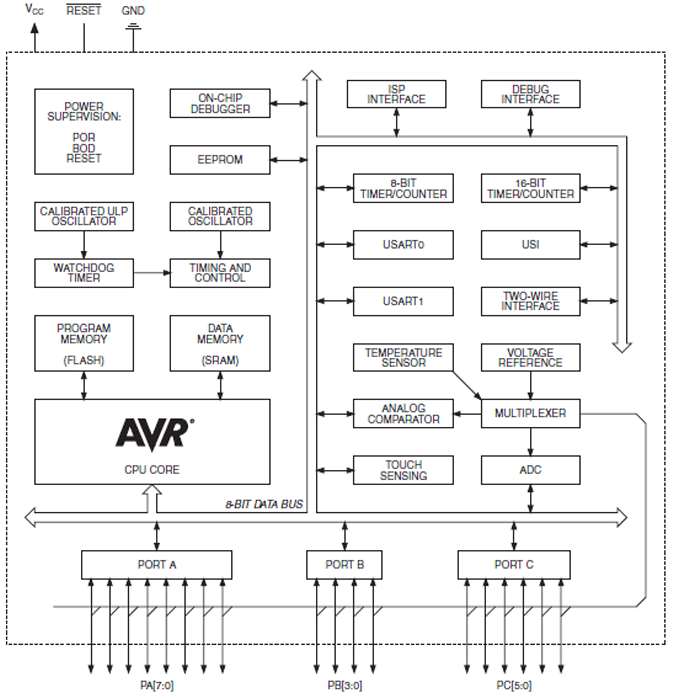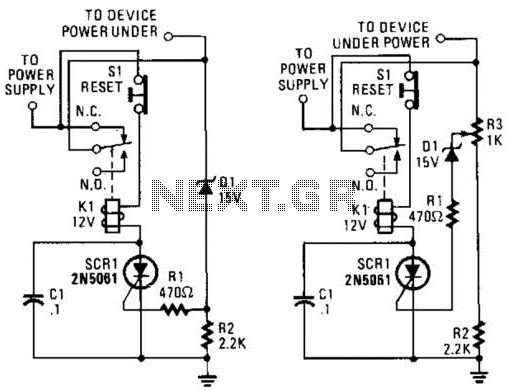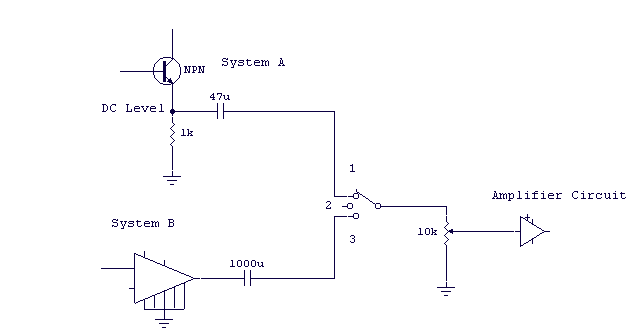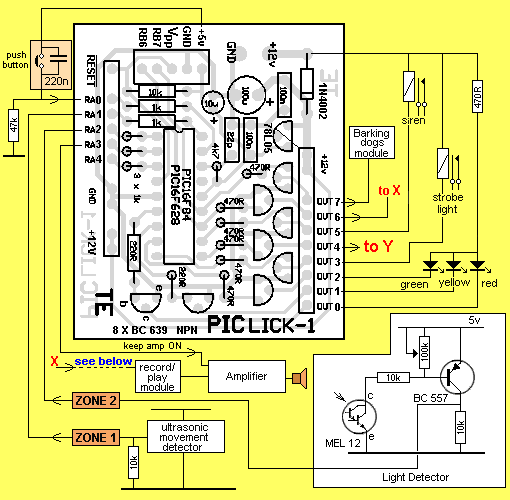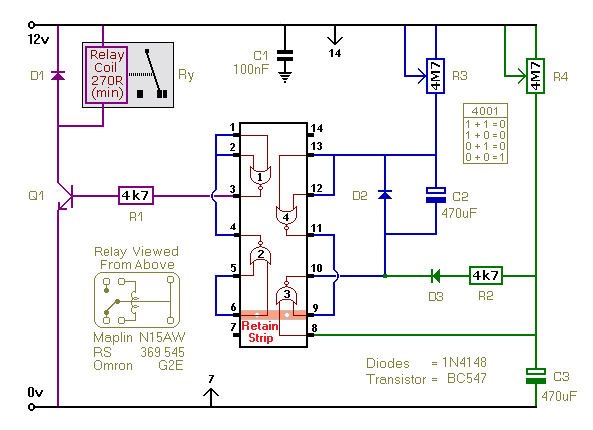
DIY Solar Tracker System Circuit
As the position of the sun changes, the illumination level on the light-dependent resistors (LDRs) also varies, causing the input voltage for the window comparator to deviate from half of the supply voltage. Consequently, the output of the comparator provides information to the motor, which adjusts the panels for optimal sun tracking. Potentiometers P1 and P2 are calibrated so that the motor remains stationary when both LDRs receive equal solar illumination. If LDR1 receives more light than LDR2, the voltage at point A rises above half of the supply voltage, resulting in a HIGH output from comparator A1, which activates transistors T1 and T4, thereby starting the motor. Conversely, if the angle of sunlight changes and the voltage at point A drops below the supply voltage, comparator A2 outputs HIGH, activating transistors T3 and T2, causing the motor to rotate in the opposite direction. For optimal solar panel control, it is recommended to utilize small motors with a suitable voltage and a maximum working current of 300 mA. This solar tracking system operates in a single plane, specifically the horizontal plane. To achieve vertical tracking of solar light, a separate sun tracker circuit is required. This circuit represents a straightforward and practical analog solar panel tracker utilizing four LDRs arranged as sensors to detect the light source. When light strikes the LDR in a specific position, it activates the circuit, triggering a relay that turns the slewing motor in the appropriate direction until the sensor is completely shaded, at which point the motor returns to its rest condition.
The described solar tracker circuit employs a simple yet effective design to maximize solar energy capture. The use of four LDRs arranged in a specific configuration allows for precise detection of light intensity from different angles. The window comparator circuit is crucial for determining the relative brightness on each LDR, effectively comparing their outputs to ascertain which side is receiving more sunlight. The transistors serve as switches that control the motor's direction based on the comparator's output. This mechanism allows the panels to continuously adjust throughout the day, following the sun’s trajectory across the sky.
For implementation, the circuit requires a power supply compatible with the motor specifications, ensuring that the maximum current does not exceed 300 mA to prevent damage to the components. The LDRs should be selected for their sensitivity to the wavelengths of sunlight, and their placement must be optimized to avoid shadows from the panels themselves. The potentiometers P1 and P2 are integral for fine-tuning the sensitivity of the circuit, allowing for adjustments based on environmental conditions or specific tracking requirements.
In summary, this analog solar tracker circuit facilitates efficient solar energy harvesting by dynamically adjusting the orientation of solar panels in response to sunlight variations, thereby enhancing the overall energy capture efficiency. For applications requiring vertical tracking, additional circuitry would need to be designed to complement the current system, ensuring comprehensive solar tracking capabilities.When the sun position is changing so does the illumination level on the LDRs and the input voltage for the window comparator is no longer half of the supply voltage thereby the output of the comparator generates informations for the motor that rotates the panels for tracking the sun. P1 and P2 are adjusted in such way that the motor stands still w hen the LDRs get the same amount of solar light. If less light reaches LDR2 than LDR1, the voltage in point A increases to more than half of the power supply voltage. As a result the output of A1 is HIGH and T1 and T4 transistors conduct. In this situation the motor is starting. If the angle of the solar light is changing again and the voltage in point A decreases at less than power supply voltage, the output of A2 goes HIGH and T3 and T2 transistors conduct.
As a result the motor is rotating in opposite direction. For solar panels control is best to use small motors with a suitable voltage and a maximum working current of 300 mA. This solar tracker system is used for tracking the sun only in one plane, the horizontal one. If you want to track the solar light in the vertical plane you need to build a separate sun tracker circuit.
This is a simple and practical analog solar panel tracker circuit. Using four LDR (light dependent resistor) as a sensor in detecting the light source arranged as illustrated. When the light hit the LDR in a certain position, it will activate the circuit and trigger the relay to turn the slewing motor in the right direction until the sensor is fully shaded under its cover stopping the motor to its rest condition.
🔗 External reference
The described solar tracker circuit employs a simple yet effective design to maximize solar energy capture. The use of four LDRs arranged in a specific configuration allows for precise detection of light intensity from different angles. The window comparator circuit is crucial for determining the relative brightness on each LDR, effectively comparing their outputs to ascertain which side is receiving more sunlight. The transistors serve as switches that control the motor's direction based on the comparator's output. This mechanism allows the panels to continuously adjust throughout the day, following the sun’s trajectory across the sky.
For implementation, the circuit requires a power supply compatible with the motor specifications, ensuring that the maximum current does not exceed 300 mA to prevent damage to the components. The LDRs should be selected for their sensitivity to the wavelengths of sunlight, and their placement must be optimized to avoid shadows from the panels themselves. The potentiometers P1 and P2 are integral for fine-tuning the sensitivity of the circuit, allowing for adjustments based on environmental conditions or specific tracking requirements.
In summary, this analog solar tracker circuit facilitates efficient solar energy harvesting by dynamically adjusting the orientation of solar panels in response to sunlight variations, thereby enhancing the overall energy capture efficiency. For applications requiring vertical tracking, additional circuitry would need to be designed to complement the current system, ensuring comprehensive solar tracking capabilities.When the sun position is changing so does the illumination level on the LDRs and the input voltage for the window comparator is no longer half of the supply voltage thereby the output of the comparator generates informations for the motor that rotates the panels for tracking the sun. P1 and P2 are adjusted in such way that the motor stands still w hen the LDRs get the same amount of solar light. If less light reaches LDR2 than LDR1, the voltage in point A increases to more than half of the power supply voltage. As a result the output of A1 is HIGH and T1 and T4 transistors conduct. In this situation the motor is starting. If the angle of the solar light is changing again and the voltage in point A decreases at less than power supply voltage, the output of A2 goes HIGH and T3 and T2 transistors conduct.
As a result the motor is rotating in opposite direction. For solar panels control is best to use small motors with a suitable voltage and a maximum working current of 300 mA. This solar tracker system is used for tracking the sun only in one plane, the horizontal one. If you want to track the solar light in the vertical plane you need to build a separate sun tracker circuit.
This is a simple and practical analog solar panel tracker circuit. Using four LDR (light dependent resistor) as a sensor in detecting the light source arranged as illustrated. When the light hit the LDR in a certain position, it will activate the circuit and trigger the relay to turn the slewing motor in the right direction until the sensor is fully shaded under its cover stopping the motor to its rest condition.
🔗 External reference
Warning: include(partials/cookie-banner.php): Failed to open stream: Permission denied in /var/www/html/nextgr/view-circuit.php on line 713
Warning: include(): Failed opening 'partials/cookie-banner.php' for inclusion (include_path='.:/usr/share/php') in /var/www/html/nextgr/view-circuit.php on line 713
